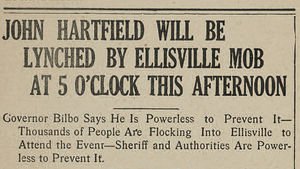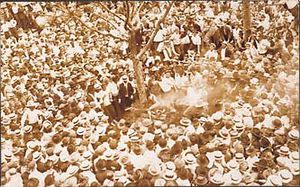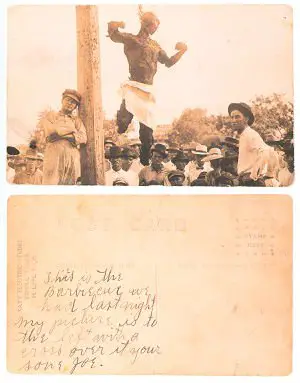What was lynching
Lynching is often described as a form of extralegal, vigilante violence or justice; however, its meaning has evolved over time—from the tarring and feathering of individuals in the Colonial period to the lethal, racial violence that proliferated in the South. According to Digital History, "Lynching received its name from Judge Charles Lynch, a Virginia farmer who punished outlaws and Tories with "rough" justice during the American Revolution."[1] The United States has a long history of vigilance committees whose purposes were to protect the community. According to Linda Gordon, “vigilantism generally means bypassing the legal procedures of the state and substituting direct, usually punitive and coercive action by self-appointed groups of citizens".[2] In some instances, vigilantism is romanticized—like in the west—as a form of outspoken, American democracy. While lynching has existed, historically, in many forms, it is most commonly associated with the form it took in the South in the late 19th century.
Lynchings as social control
According to the group Monroe Work Today, by 1835, lynchings were more common and more leathal. In the middle of the 19th century lynchings were “a crude form of frontier justice done by vigilantes ‘keeping the peace,’” and approximately 40% of lynchings in this period were done to white men.[3] Contrary to popular belief, lynchings frequently occurred in places where there were courthouses. Lynchings were not a symptom of lawlessness. Rather, as lynchings began to occur more frequently in the west, they were tools of violence used against non-white groups to challenge the slow pace of the legal system, in favor of immediate action. Before 1877 (the end of Reconstruction), most lynchings happened in the West. Lynching victims also varied by region. Those that occurred in the North typically targeted Italians, Jews, or other immigrants, while those in the west targeted Mexicans or Chinese. Nevertheless, beginning in the 1880s, approximately 90% of lynchings occurred in the South and happened to black men.
Lynchings began to be used more systematically in the South in the late 19th century. The late 19th century witnessed a social transformation for African Americans in the South. Newly-enfranchised, many African Americans began to exercise their legal and social rights. In the absence of system of legal subjugation that ensured white supremacy (i.e. slavery), lynchings were a constant and imminent threat that prevented African Americans in the South from truly being free. Lynchings served as a system of terror designed around reinforcing African-Americans’ second-class status.
Southern Horrors
In 1892, Ida B. Wells wrote Southern Horrors to document the practice of lynching in the South after three of her friends in Memphis were killed by a mob for operating a black-owned grocery store. Their lynching, and her subsequent pamphlet, inspired the teacher to pursue investigative journalism and an anti-lynching campaign.
In Southern Horrors, Wells wrote: "This statement is not a shield for the despoiler of virtue, nor altogether a defense for the poor blind Afro-American Sampsons who suffer themselves to be betrayed by white Delilahs. It is a contribution to truth, an array of facts, the perusal of which it is hoped will stimulate this great American Republic to demand that justice be done though the heavens fall. It is with no pleasure I have dipped my hands in the corruption here exposed. Somebody must show that the Afro-American race is more sinned against than sinning, and it seems to have fallen upon me to do so. The awful death-roll that Judge Lynch is calling every week is appalling, not only because of the lives it takes, the rank cruelty and outrage to the victims, but because of the prejudice it fosters and the stain it places against the good name of a weak race. The Afro-American is not a bestial race. If this work can contribute in any way toward proving this, and at the same time arouse the conscience of the American people to a demand for justice to every citizen, and punishment by law for the lawless, I shall feel I have done my race a service...".[4]
Wells wrote these because one of the most common assertions—or justifications for lynchings—was rape. Fears about miscegenation, or race mixing, shrouded criticisms against the Republican party during the Civil War, and after, many Southern whites feared that black equality was simply a way to legalize miscegenation. Other white Southerners believed that slavery had tamed African-Americans’ bestial, animal nature by introducing them to white civilization. Outside of the institution of slavery, blacks were reverting to their savage tendencies.[5]
Wells found that African-Americans were lynching for a host of reasons—for competing economically with whites (like her friends), for being drunk in public, or for failing to respect whites. Nevertheless, the rape justification seemed to reverberate the most, and seemed to inspire the greatest reactions.
Wells attempted to make the lynching issue known to Americans outside of the South. Before her pamphlet (and even shortly after), lynching was not widely discussed in Northern Newspapers. In 1893 and 1894, Wells went to England as part of her anti-lynching campaign. She believed that British journalists could help bring awareness of the lynching issue to Northern newspapers. Southern Horrors impugned white American civilization. She portrayed black men as innocent victims of white female seductresses, and she personified the lynch mob as uncivilized and brute. The only way for Americans to assert their civilization, would be by stopping the practice of lynching.
Wells was correct, and when she returned to the US after her 1894 tour, “she returned to a country where lynching was widely discussed as a stain on American civilization.”[6]
20th Century
Northern and British distaste, however, did very little for African-Americans in the South as lynchings continued to occur. According to some estimates, some 2,400 African Americans were lynched between 1889 and 1918. These events were community sanctioned, and the victims were often beaten, tortured, and mutilated before death. After death, photographs were sold as souvenirs to commemorate attendance or participation, and body parts—teeth, fingers, ashes, and clothes—were sold or taken as tokens.
Lynchings were not private events performed under the cover of darkness. They were frequently publicized in advance. As lynchings moved into the 20th century, they became modern carnival-esque spectacles. Sheriffs, clergymen, and the city’s best businessmen participated. Railroads sometimes advertised upcoming events—allowing individuals to watch or participate at a lowered excursion rate. In some instances, tickets were sold, and crowds swelled to 15,000 people.[1]
Lynchings remained an unfortunate reality for many African-Americans through the first half of the 20th century. In 1955, 14-year-old Emmett Till, a Chicago boy, was lynched in Mississippi after purportedly flirting with a white woman (Recently, journalist Timothy Tyson has released an interview with Carolyn Bryant--the women who accused Till of acting inappropriately with her. According to her own admission, she fabricated the parts of the story where she said he got physical with her). Several days after the incident, Till was abducted, mutilated, murdered, and thrown into a river. His mother demanded a public funeral with an open casket to show the world what had happened to her son. An all-white jury acquitted the men involved, even though they later admitted their involvement. This case generated widespread attention because of Till’s young age, the brutality of the crime, and his attackers’ acquittal. It also helped to start a new phase of the Civil Rights Movement in the South. The last official lynching was recorded in 1968, though many would argue that James Byrd’s murder in 1998 at the hands of three white men was a lynching as well.
References
- ↑ 1.0 1.1 [1], Digital History.
- ↑ Linda Gordon, The Great Arizona Orphan Abduction, p. 255.
- ↑ [2], Monroe Work Today, The Rise of Lynchings.
- ↑ [3], Ida B. Wells, Southern Horrors.
- ↑ Gail Bederman, Manliness & Civilization: A Cultural History of Gender and Race in the United States, 1880-1917 p. 46-53.
- ↑ Gail Bederman, Manliness & Civilization: A Cultural History of Gender and Race in the United States, 1880-1917 p. 45".


